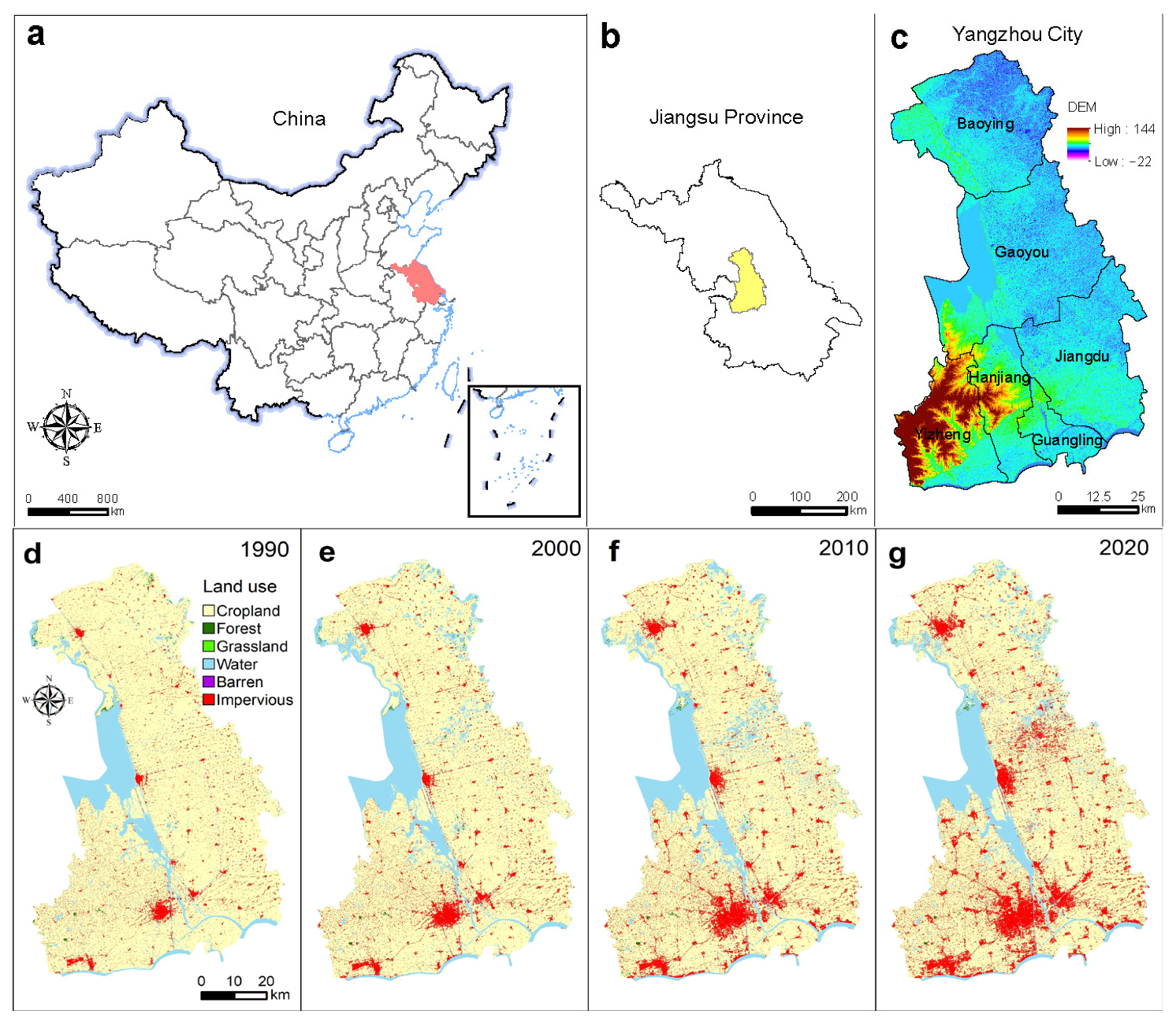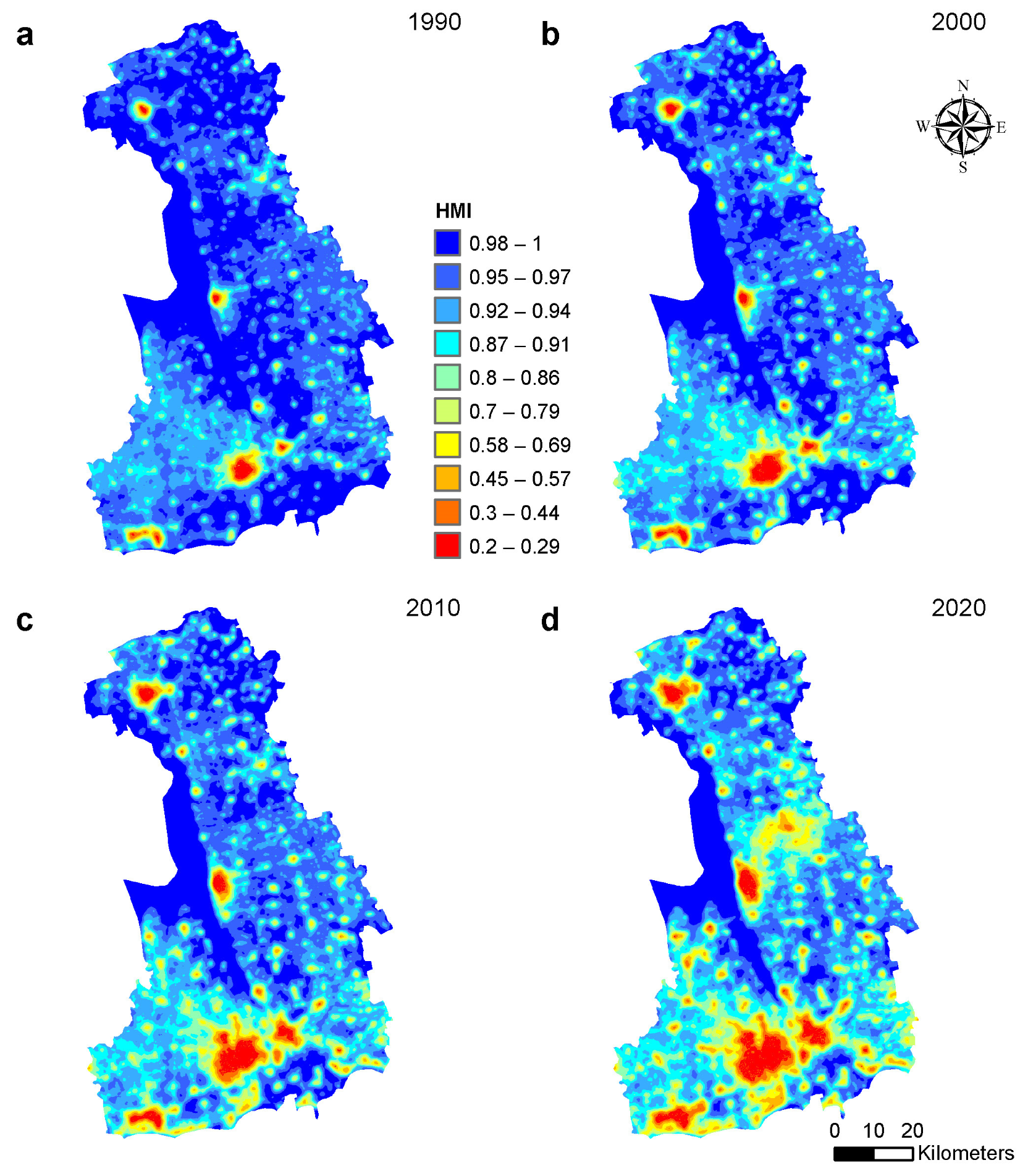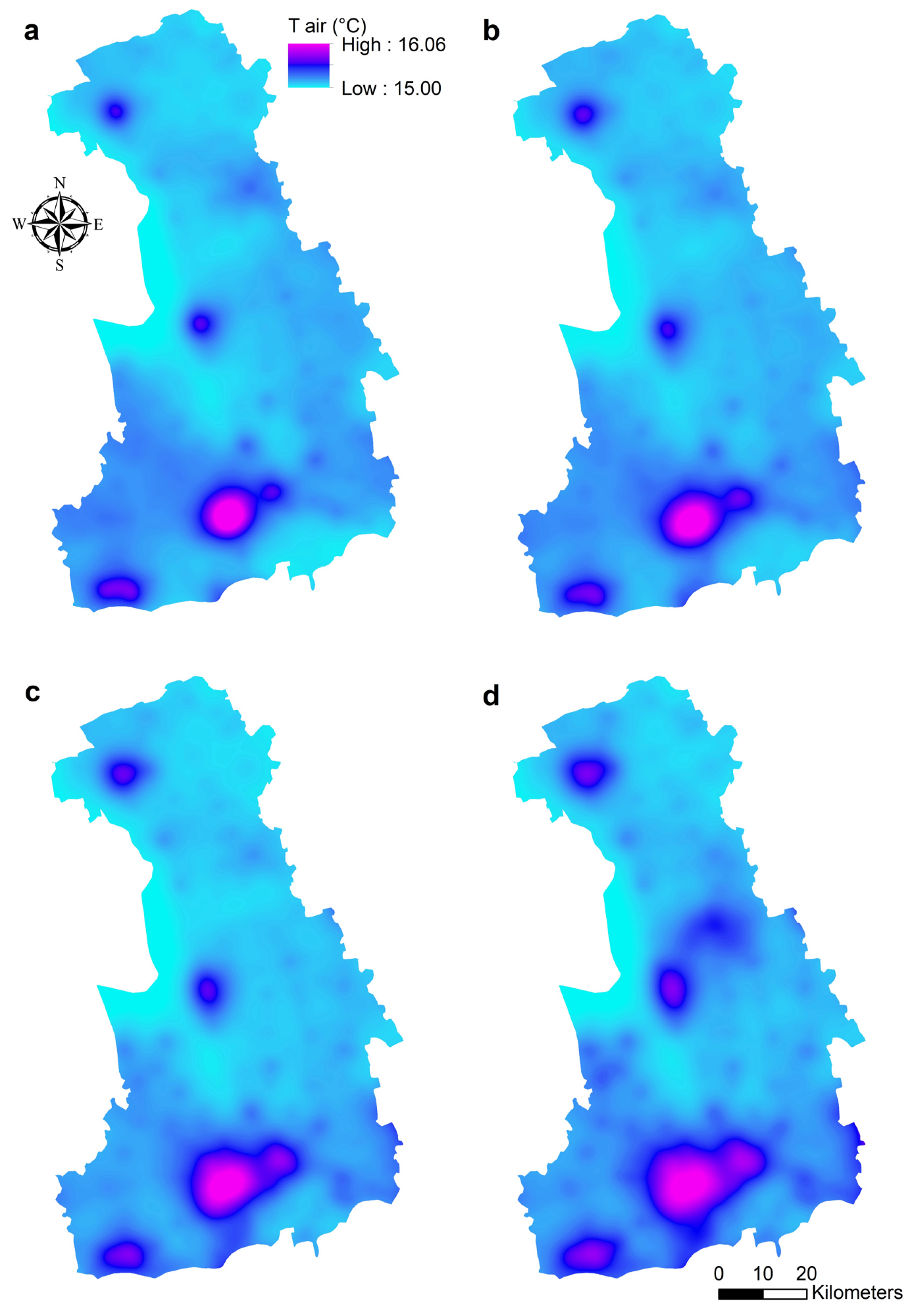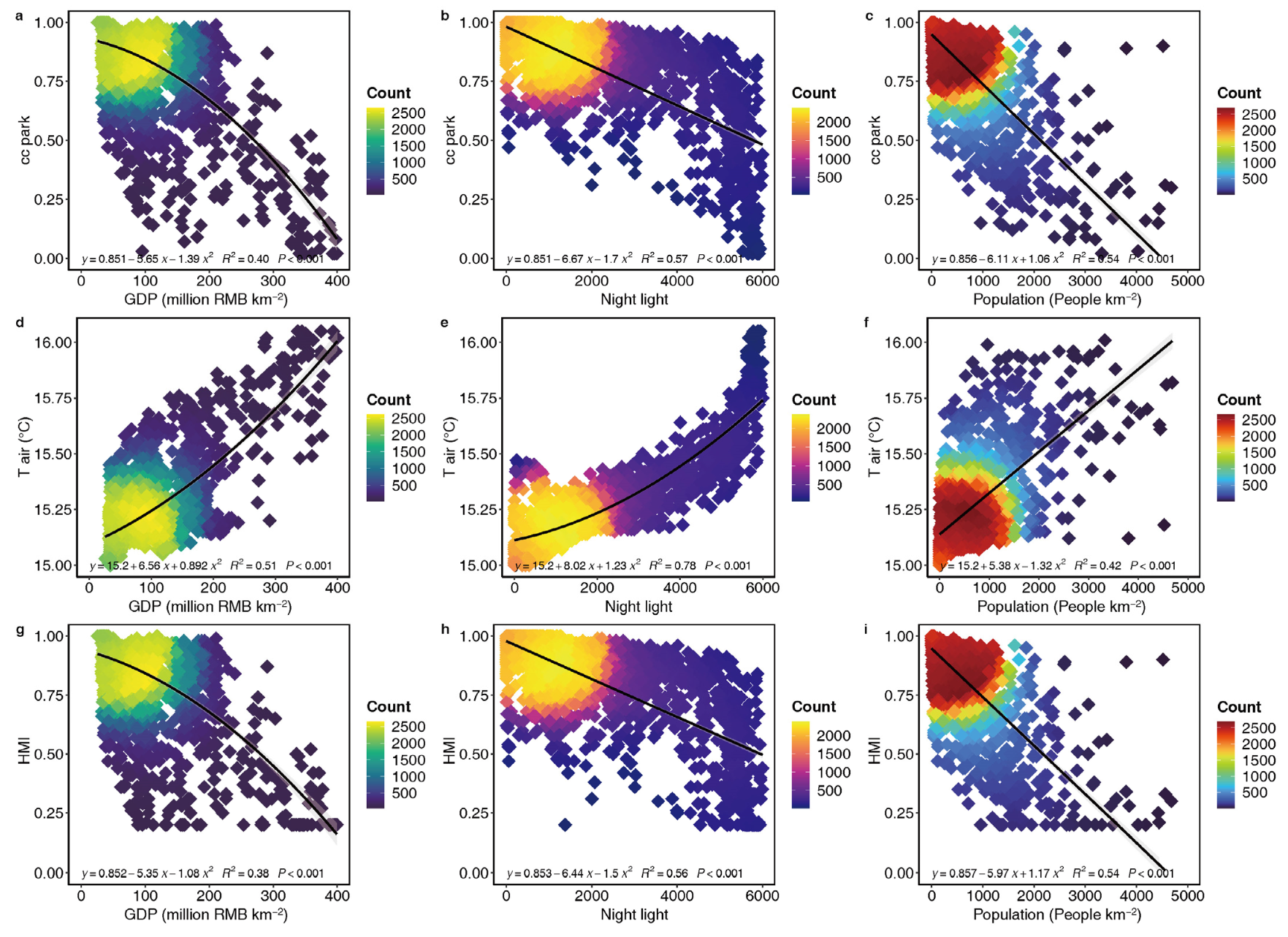Spatio-Temporal Heterogeneity of the Urban Heat Effect and Its Socio-Ecological Drivers in Yangzhou City, China
Abstract
:1. Introduction
2. Materials and Methods
2.1. Study Area
2.2. Data Source
2.3. Assessment of the Urban Heat Island Effect
2.4. Calculation of the Landscape Pattern Index
2.5. Statistical Analysis
3. Results
3.1. Spatio-Temporal Heterogeneity of the Urban Heat Island Effect
3.2. Changes in the Landscape Pattern Index
3.3. Driving Factors of the Urban Heat Island Effect
4. Discussion
4.1. Spatio-Temporal Dynamics of Urban Heat Island and Socio-Ecological Drivers
4.2. Implications for Urban Planning and Management
4.3. Limitations
5. Conclusions
Supplementary Materials
Author Contributions
Funding
Data Availability Statement
Conflicts of Interest
References
- Deng, X.; Gao, F.; Liao, S.; Liu, Y.; Chen, W. Spatiotemporal Evolution Patterns of Urban Heat Island and Its Relationship with Urbanization in Guangdong-Hong Kong-Macao Greater Bay Area of China from 2000 to 2020. Ecol. Indic. 2023, 146, 109817. [Google Scholar] [CrossRef]
- Zhang, K.; Cao, C.; Chu, H.; Zhao, L.; Zhao, J.; Lee, X. Increased Heat Risk in Wet Climate Induced by Urban Humid Heat. Nature 2023, 617, 738–742. [Google Scholar] [CrossRef] [PubMed]
- Peng, J.; Qiao, R.; Wang, Q.; Yu, S.; Dong, J.; Yang, Z. Diversified Evolutionary Patterns of Surface Urban Heat Island in New Expansion Areas of 31 Chinese Cities. npj Urban Sustain. 2024, 4, 14. [Google Scholar] [CrossRef]
- Cabon, V.; Quénol, H.; Dubreuil, V.; Ridel, A.; Bergerot, B. Urban Heat Island and Reduced Habitat Complexity Explain Spider Community Composition by Excluding Large and Heat-Sensitive Species. Land 2024, 13, 83. [Google Scholar] [CrossRef]
- Niu, L.; Zhang, Z.; Peng, Z.; Liang, Y.; Liu, M.; Jiang, Y.; Wei, J.; Tang, R. Identifying Surface Urban Heat Island Drivers and Their Spatial Heterogeneity in China’s 281 Cities: An Empirical Study Based on Multiscale Geographically Weighted Regression. Remote Sens. 2021, 13, 4428. [Google Scholar] [CrossRef]
- Geng, X.; Zhang, D.; Li, C.; Yuan, Y.; Yu, Z.; Wang, X. Impacts of Climatic Zones on Urban Heat Island: Spatiotemporal Variations, Trends, and Drivers in China from 2001–2020. Sustain. Cities Soc. 2023, 89, 104303. [Google Scholar] [CrossRef]
- Dewan, A.; Kiselev, G.; Botje, D.; Mahmud, G.I.; Bhuian, M.H.; Hassan, Q.K. Surface Urban Heat Island Intensity in Five Major Cities of Bangladesh: Patterns, Drivers and Trends. Sustain. Cities Soc. 2021, 71, 102926. [Google Scholar] [CrossRef]
- Nuruzzaman, M. Urban Heat Island: Causes, Effects and Mitigation Measures—A Review. Int. J. Environ. Monit. Anal. 2015, 3, 67–73. [Google Scholar] [CrossRef]
- Chen, L.; Ma, Y. Exploring the Spatial and Temporal Changes of Carbon Storage in Different Development Scenarios in Foshan, China. Forests 2022, 13, 2177. [Google Scholar] [CrossRef]
- Phelan, P.E.; Kaloush, K.; Miner, M.; Golden, J.; Phelan, B.; Silva, H.; Taylor, R.A. Urban Heat Island: Mechanisms, Implications, and Possible Remedies. Annu. Rev. Environ. Resour. 2015, 40, 285–307. [Google Scholar] [CrossRef]
- Zawadzka, J.E.; Harris, J.A.; Corstanje, R. Assessment of Heat Mitigation Capacity of Urban Greenspaces with the Use of InVEST Urban Cooling Model, Verified with Day-Time Land Surface Temperature Data. Landsc. Urban Plan. 2021, 214, 104163. [Google Scholar] [CrossRef]
- InVest. User’s Guide. Available online: http://releases.naturalcapitalproject.org/invest-userguide/latest/en/urban_cooling_model.html (accessed on 8 September 2024).
- Ronchi, S.; Salata, S.; Arcidiacono, A. Which Urban Design Parameters Provide Climate-Proof Cities? An Application of the Urban Cooling InVEST Model in the City of Milan Comparing Historical Planning Morphologies. Sustain. Cities Soc. 2020, 63, 102459. [Google Scholar] [CrossRef]
- Hou, H.; Longyang, Q.; Su, H.; Zeng, R.; Xu, T.; Wang, Z.H. Prioritizing Environmental Determinants of Urban Heat Islands: A Machine Learning Study for Major Cities in China. Int. J. Appl. Earth Obs. Geoinf. 2023, 122, 103411. [Google Scholar] [CrossRef]
- Lauwaet, D.; Berckmans, J.; Hooyberghs, H.; Wouters, H.; Driesen, G.; Lefebre, F.; De Ridder, K. High Resolution Modelling of the Urban Heat Island of 100 European Cities. Urban Clim. 2024, 54, 101850. [Google Scholar] [CrossRef]
- Pan, Y.; Wu, Y.; Xu, X.; Zhang, B.; Li, W. Identifying Terrestrial Landscape Character Types in China. Land 2022, 11, 1014. [Google Scholar] [CrossRef]
- Jia, Y.; Tang, L.; Xu, M.; Yang, X. Landscape Pattern Indices for Evaluating Urban Spatial Morphology—A Case Study of Chinese Cities. Ecol. Indic. 2019, 99, 27–37. [Google Scholar] [CrossRef]
- Tan, C.; Xu, B.; Hong, G.; Wu, X. Integrating Habitat Risk and Landscape Resilience in Forest Protection and Restoration Planning for Biodiversity Conservation. Landsc. Urban Plan. 2024, 248, 105111. [Google Scholar] [CrossRef]
- Hu, D.; Wang, R.-S.; Lei, K.-P.; Li, F.; Wang, Z.; Wang, B.-N. Expanding Ecological Appropriation Approach: Solar Space Method and a Case Study in Yangzhou City, East China. Ecol. Complex. 2009, 6, 473–483. [Google Scholar] [CrossRef]
- Yang, J.; Huang, X. 30 m Annual Land Cover and Its Dynamics in China from 1990 to 2019. Earth Syst. Sci. Data Discuss. 2021, 4417810, 3907–3925. [Google Scholar] [CrossRef]
- Zomer, R.J.; Xu, J.; Trabucco, A. Version 3 of the Global Aridity Index and Potential Evapotranspiration Database. Sci. Data 2022, 9, 409. [Google Scholar] [CrossRef]
- Hu, Y.; Wang, C.; Li, J. Assessment of Heat Mitigation Services Provided by Blue and Green Spaces: An Application of the InVEST Urban Cooling Model with Scenario Analysis in Wuhan, China. Land 2023, 12, 963. [Google Scholar] [CrossRef]
- Zardo, L.; Geneletti, D.; Pérez-Soba, M.; Van Eupen, M. Estimating the Cooling Capacity of Green Infrastructures to Support Urban Planning. Ecosyst. Serv. 2017, 26, 225–235. [Google Scholar] [CrossRef]
- McDonald, R.; Kroeger, T.; Boucher, T.; Longzhu, W.; Salem, R.; Adams, J.; Bassett, S.; Edgecomb, M.; Garg, S. Planting Healthy Air: A Global Analysis of the Role of Urban Trees in Addressing Particulate Matter Pollution and Extreme Heat; CAB International: Wallingford, UK, 2016. [Google Scholar]
- Ren, S.; Zhao, H.; Zhang, H.; Wang, F.; Yang, H. Influence of Natural and Social Economic Factors on Landscape Pattern Indices—The Case of the Yellow River Basin in Henan Province. Water 2023, 15, 4175. [Google Scholar] [CrossRef]
- Xi, Y.; Wang, S.; Zou, Y.; Zhou, X.C.; Zhang, Y. Seasonal Surface Urban Heat Island Analysis Based on Local Climate Zones. Ecol. Indic. 2024, 159, 111669. [Google Scholar] [CrossRef]
- Deng, X.; Cao, Q.; Wang, L.; Wang, W.; Wang, S.; Wang, S.; Wang, L. Characterizing Urban Densification and Quantifying Its Effects on Urban Thermal Environments and Human Thermal Comfort. Landsc. Urban Plan. 2023, 237, 104803. [Google Scholar] [CrossRef]
- Abbassi, Y.; Ahmadikia, H.; Baniasadi, E. Impact of Wind Speed on Urban Heat and Pollution Islands. Urban Clim. 2022, 44, 101200. [Google Scholar] [CrossRef]
- Zhao, Y.; Li, H.; Bardhan, R.; Kubilay, A.; Li, Q.; Carmeliet, J. The Time-Evolving Impact of Tree Size on Nighttime Street Canyon Microclimate: Wind Tunnel Modeling of Aerodynamic Effects and Heat Removal. Urban Clim. 2023, 49, 101528. [Google Scholar] [CrossRef]
- Wu, H.; Wang, T.; Riemer, N.; Chen, P.; Li, M.; Li, S. Urban Heat Island Impacted by Fine Particles in Nanjing, China. Sci. Rep. 2017, 7, 11422. [Google Scholar] [CrossRef]
- Ramírez-Aguilar, E.A.; Lucas Souza, L.C. Urban Form and Population Density: Influences on Urban Heat Island Intensities in Bogotá, Colombia. Urban Clim. 2019, 29, 100497. [Google Scholar] [CrossRef]
- Woolway, R.I.; Zhao, G.; Rocha, S.M.G.; Thackeray, S.J.; Armstrong, A. Decarbonization Potential of Floating Solar Photovoltaics on Lakes Worldwide. Nat. Water 2024, 2, 566–576. [Google Scholar] [CrossRef]
- Jahangir, M.H.; Zarfeshani, A.; Arast, M. Investigation of Green Roofs Effects on Reducing of the Urban Heat Islands Formation (The Case of a Municipal District of Tehran City, Iran). Nat.-Based Solut. 2024, 5, 100100. [Google Scholar] [CrossRef]
- Zhao, Y.; Sen, S.; Susca, T.; Iaria, J.; Kubilay, A.; Gunawardena, K.; Zhou, X.; Takane, Y.; Park, Y.; Wang, X.; et al. Beating Urban Heat: Multimeasure-Centric Solution Sets and a Complementary Framework for Decision-Making. Renew. Sustain. Energy Rev. 2023, 186, 113668. [Google Scholar] [CrossRef]
- Li, H.; Zhao, Y.; Bardhan, R.; Chan, P.W.; Derome, D.; Luo, Z.; Ürge-Vorsatz, D.; Carmeliet, J. Relating Three-Decade Surge in Space Cooling Demand to Urban Warming. Environ. Res. Lett. 2023, 18, 124033. [Google Scholar] [CrossRef]





| Data | Representative Year | Spatial Resolution | Source |
|---|---|---|---|
| Land cover | 1990, 2000, 2010, and 2020 | 0.03 × 0.03 km | Yang and Huang (2021) [20] (https://zenodo.org/records/8176941, accessed on 8 September 2024) |
| Digital elevation (DEM) | – | 0.03 × 0.03 km | Geospatial data cloud (http://www.gscloud.cn, accessed on 8 September 2024) |
| Potential evapotranspiration | Annual average | 1 × 1 km | Zomer et al. (2022) [21] (https://doi.org/10.6084/m9.figshare.7504448.v5, accessed on 8 September 2024) |
| Gross domestic product (GDP) | 2020 | 1 × 1 km | Resource and Environment Science and Data Center, Chinese Academy of Sciences (RESDC) (https://www.resdc.cn/Default.aspx, accessed on 8 September 2024) |
| Night-light index | 2020 | 1 × 1 km | National Tibetan Plateau Data Center (TPDC) (https://data.tpdc.ac.cn/home, accessed on 8 September 2024) |
| Population density | 2020 | 1 × 1 km | RESDC (https://www.resdc.cn/Default.aspx, accessed on 8 September 2024) |
| Land Cover Type | Kc | Green_Area | Shade | Albedo |
|---|---|---|---|---|
| Cropland | 0.6 | 1 | 0.3 | 0.2 |
| Forest | 1 | 1 | 0.9 | 0.3 |
| Grassland | 0.65 | 1 | 0.5 | 0.2 |
| Water | 1 | 1 | 0.1 | 0.1 |
| Barren | 0.2 | 0 | 0 | 0.27 |
| Impervious | 0.3 | 0 | 0.2 | 0.15 |
| Year | cc Park | HMI | T Air (°C) | ||||||
|---|---|---|---|---|---|---|---|---|---|
| Mean ± S.D. | Min | Max | Mean ± S.D. | Min | Max | Mean ± S.D. | Min | Max | |
| 1990 | 0.94 ± 0.08 | 0.02 | 1.00 | 0.94 ± 0.08 | 0.20 | 1.00 | 15.08 ± 0.06 | 15.00 | 15.66 |
| 2000 | 0.92 ± 0.11 | 0.01 | 1.00 | 0.92 ± 0.10 | 0.20 | 1.00 | 15.11 ± 0.09 | 15.00 | 15.84 |
| 2010 | 0.89 ± 0.14 | 0.01 | 1.00 | 0.89 ± 0.14 | 0.20 | 1.00 | 15.16 ± 0.14 | 15.00 | 15.98 |
| 2020 | 0.85 ± 0.17 | 0.01 | 1.00 | 0.85 ± 0.17 | 0.17 | 1.00 | 15.22 ± 0.17 | 15.00 | 16.06 |
| Land Cover Type | Year | CA | PLAND | NP | PD | AI |
|---|---|---|---|---|---|---|
| m2 | % | % | ||||
| Cropland | 1990 | 549,032 | 83.4 | 2943 | 0.447 | 96.4 |
| 2000 | 521,205 | 79.2 | 5254 | 1.798 | 95.8 | |
| 2010 | 492,948 | 74.9 | 7936 | 1.205 | 94.8 | |
| 2020 | 467,436 | 71.0 | 9897 | 1.503 | 93.8 | |
| Impervious | 1990 | 36,497 | 5.5 | 51,499 | 7.822 | 61.3 |
| 2000 | 51,004 | 7.7 | 47,980 | 7.288 | 69.6 | |
| 2010 | 70,574 | 10.7 | 46,553 | 7.071 | 74.6 | |
| 2020 | 98,994 | 15.0 | 46,529 | 7.067 | 78.3 |
| Land Cover Type | cc Park | HMI | T Air | CA | PLAND | NP | PD | AI | |
|---|---|---|---|---|---|---|---|---|---|
| Cropland | cc park | 1 | 1.000 ** | −1.000 ** | 0.986 * | 0.989 * | −0.983 * | −0.938 | 0.978 * |
| HMI | 1 | −1.000 ** | 0.986 * | 0.989 * | −0.983 * | −0.938 | 0.978 * | ||
| T air | 1 | −0.987 * | −0.990 * | 0.984 * | 0.932 | −0.980 * | |||
| CA | 1 | 1.000 ** | −0.999 ** | −0.945 | 0.939 | ||||
| PLAND | 1 | −0.998 ** | −0.949 | 0.944 | |||||
| NP | 1 | 0.932 | −0.939 | ||||||
| PD | 1 | −0.853 | |||||||
| IJI | 0.944 | ||||||||
| AI | 1 | ||||||||
| Impervious | cc park | 1 | 1.000 ** | −1.000 ** | −1.000** | −1.000 ** | 0.828 | 0.681 | −0.927 |
| HMI | 1 | −1.000 ** | −1.000** | −1.000 ** | 0.828 | 0.681 | −0.927 | ||
| T air | 1 | 0.999** | 1.000 ** | −0.830 | −0.680 | 0.928 | |||
| CA | 1 | 1.000 ** | −0.828 | −0.685 | 0.927 | ||||
| PLAND | 1 | −0.828 | −0.681 | 0.927 | |||||
| NP | 1 | 0.957 * | −0.978 * | ||||||
| PD | 1 | −0.896 | |||||||
| IJI | 0.930 | ||||||||
| AI | 1 |
Disclaimer/Publisher’s Note: The statements, opinions and data contained in all publications are solely those of the individual author(s) and contributor(s) and not of MDPI and/or the editor(s). MDPI and/or the editor(s) disclaim responsibility for any injury to people or property resulting from any ideas, methods, instructions or products referred to in the content. |
© 2024 by the authors. Licensee MDPI, Basel, Switzerland. This article is an open access article distributed under the terms and conditions of the Creative Commons Attribution (CC BY) license (https://creativecommons.org/licenses/by/4.0/).
Share and Cite
Wu, T.; Wang, Z.; Xu, Q. Spatio-Temporal Heterogeneity of the Urban Heat Effect and Its Socio-Ecological Drivers in Yangzhou City, China. Land 2024, 13, 1470. https://doi.org/10.3390/land13091470
Wu T, Wang Z, Xu Q. Spatio-Temporal Heterogeneity of the Urban Heat Effect and Its Socio-Ecological Drivers in Yangzhou City, China. Land. 2024; 13(9):1470. https://doi.org/10.3390/land13091470
Chicago/Turabian StyleWu, Tao, Zhaoyi Wang, and Qiang Xu. 2024. "Spatio-Temporal Heterogeneity of the Urban Heat Effect and Its Socio-Ecological Drivers in Yangzhou City, China" Land 13, no. 9: 1470. https://doi.org/10.3390/land13091470







